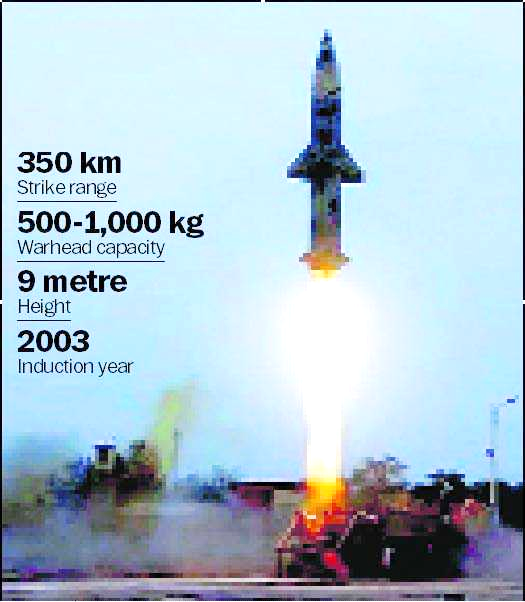Science & Technology
Prithvi-II Missile
- 16 Jun 2022
- 5 min read
For Prelims: Prithvi II, DRDO, IGMDP, Agni IV, Ballistic Missiles, Various types of Missiles
For Mains: Missile Technology of India, IGMDP
Why in News?
Recently, India successfully conducted the night trial of surface-to-surface nuclear-capable short-range ballistic missile Prithvi-II.
- Earlier, Intermediate Range Ballistic Missile Agni-IV was tested which can travel as far as 4,000 km.
What are the Key Highlights about Prithivi-II Missile?
- About:
- Prithvi-II is an indigenously developed Surface-to-Surface Missile Short-Range Ballistic Missile (SRBM), which has a range of around 250 km-350km and can carry a one tonne payload.
- Prithvi II class is a single-stage liquid-fueled missile that has warhead mounting capability of 500 kg-1000kg.
- The missile is a proven system and is capable of striking targets with a very high degree of precision.
- The state-of-the-art missile uses an advanced inertial guidance system with manoeuvring trajectory to hit its target.
- It was initially developed for the Indian Air Force as its primary user and was later inducted into the Indian Army as well.
- While the missile was inducted into India's Strategic Forces Command for the first time in 2003, it was the first missile developed under the IGMDP.
- Developed by:
- Defence Research and Development Organisation (DRDO) of India under its Integrated Guided Missile Development Programme (IGMDP).
What are the Prithvi Missiles?
- The Prithvi missile system comprises various tactical Surface-to-Surface Short-Range Ballistic Missiles (SRBM).
- Its development began in 1983, and it was India’s first indigenous ballistic missile.
- It was first test-fired in 1988, from Sriharikota, SHAR Centre.
- It has a range of from 150 to 300 km.
- The naval variant of Prithvi I and Prithvi III class missiles have the code-name Dhanush.
- The propulsion technology was likely based on the Soviet SA-2 surface-to-air missile.
- Soviet SA-2 Surface-to-Air Missile:
- Developed in the mid-1950s, the Soviet SA-2 surface-to-air missile was the first effective Soviet Union surface-to-air missile.
- Developed as a missile for the battlefield, it could carry a nuclear warhead in its role as a tactical nuclear weapon.
- Soviet SA-2 Surface-to-Air Missile:
- The Prithvi I missiles have been in service with the Indian Army since 1994.
- Reportedly, Prahar missiles are replacing with Prithvi I missiles.
- Prithvi II missiles have been in service since 1996.
- Prithvi III having a more extended range of 350 km, was successfully test-fired in 2004.
What is Integrated Guided Missile Development Programme (IGMDP)?
- About:
- IGMDP was an Indian Ministry of Defence programme to research and develop a comprehensive range of missiles.
- The project started in 1982–1983 under the leadership of Dr APJ Abdul Kalam.
- This Programme made Dr APJ Abdul Kalam the missile man of India.
- The integrated guided missile programme was complete in, 2008.
- Five Missiles Developed under the IGMDP:
- PRITHVI (Short range surface-to-surface ballistic missile)
- AGNI (Medium to intercontinental surface-to-surface missile)
- TRISHUL (Short range low-level surface-to-air missile)
- AKASH (Surface-to-air missile having a range of up to 25 Km and multi-target handling system)
- NAG (Third generation “fire & forget”, “top attack” anti-tank missile)
UPSC Civil Services Examination, Previous Year Question(PYQ)
Q. With reference to Agni-IV Missile, which of the following statements is/are correct? (2014)
- It is a surface-to-surface missile.
- It is fuelled by liquid propellant only.
- It can deliver one-tonne nuclear warheads about 7500 km away.
Select the correct answer using the code given below:
(a) 1 only
(b) 2 and 3 only
(c) 1 and 3 only
(d) 1, 2 and 3
Ans: (a)
Exp:
- Agni-IV is a nuclear-capable long-range ballistic missile of India, with a strike range of 4,000 km.
- The indigenously developed Agni-IV is a two-stage surface-to-surface missile. It is 20 metres long with a weight of 17 tonnes. Hence, statement 1 is correct.
- It is a two stage solid fuelled system that can carry a one-tonne nuclear warhead over a distance of 4,000 kilometres. Hence, statements 2 and 3 are not correct.
- Therefore, option (a) is the correct answer.





